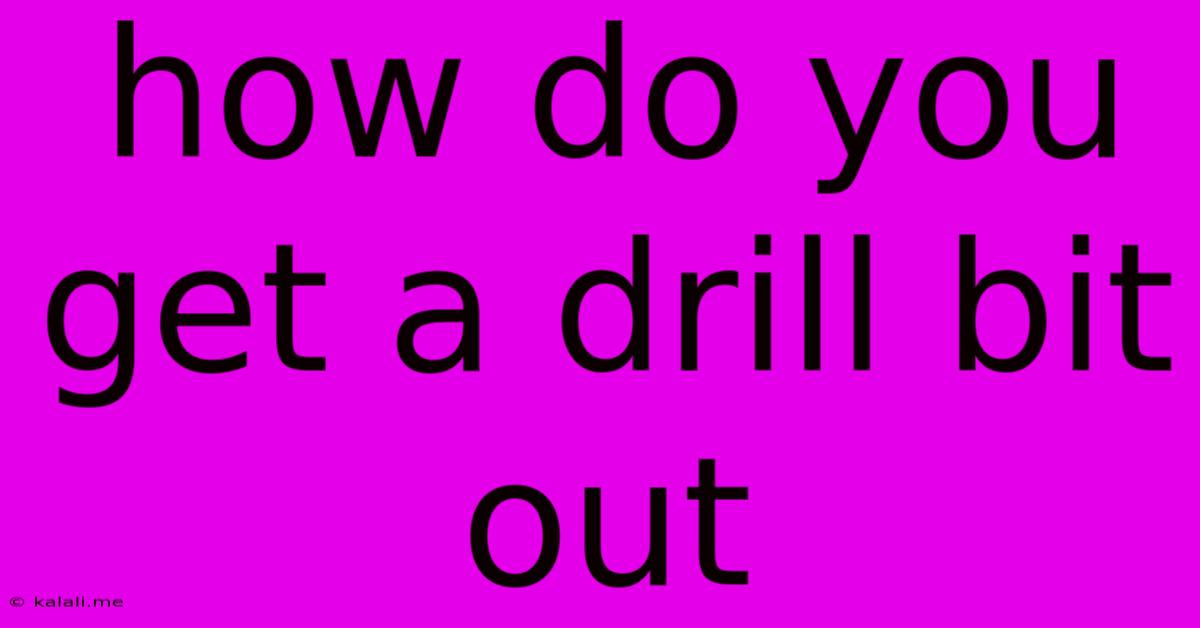How Do You Get A Drill Bit Out
Kalali
Jun 07, 2025 · 3 min read

Table of Contents
How to Get a Stuck Drill Bit Out: A Comprehensive Guide
Getting a drill bit stuck is frustrating, but it's a common problem for DIYers and professionals alike. This comprehensive guide will walk you through various techniques to remove a stubborn drill bit, from simple solutions to more advanced methods. We'll cover different scenarios and drill types, ensuring you have the knowledge to tackle this issue effectively.
Why Drill Bits Get Stuck: Before diving into extraction methods, understanding why a bit gets stuck is crucial. Common culprits include:
- Excessive pressure: Applying too much force during drilling can cause the bit to bind.
- Overheating: Heat generated during drilling can cause the metal to expand, leading to a tight fit.
- Material type: Hard materials like concrete or steel are more likely to cause bits to seize.
- Clamping force: A poorly secured chuck can allow the bit to slip and become jammed.
- Broken bit: A snapped drill bit can be incredibly difficult to remove.
Methods for Removing a Stuck Drill Bit:
The best method depends on the severity of the jam and the type of drill bit involved. Let's explore various approaches:
1. Reverse Rotation & Gentle Pressure:
- The Basics: This is the first and often most effective method. Simply reverse the drill's direction and apply gentle pressure. Avoid forceful twisting, which can damage the drill or workpiece.
- When it Works Best: Ideal for bits that are only slightly stuck and haven't been subjected to excessive heat.
- Important Note: Always ensure the chuck is securely tightened before attempting this.
2. Penetrating Oil:
- The Process: Apply a penetrating oil (like WD-40 or a similar product) to the stuck bit. Let it sit for several minutes to penetrate the interface between the bit and the material. Then, try reverse rotation again.
- Why it Works: Penetrating oils lubricate the surfaces, reducing friction and making it easier to remove the bit.
- When it Works Best: Particularly helpful when dealing with rusted or corroded metal.
3. Vice Grips or Pliers:
- The Technique: If reverse rotation fails, carefully grip the exposed portion of the drill bit with vice grips or pliers. Apply firm, steady pressure while gently twisting the bit counter-clockwise.
- Cautions: Be mindful not to damage the bit or the workpiece with excessive force. Use appropriately sized vice grips for a secure grip.
- When it Works Best: Effective when a significant portion of the bit is still protruding.
4. Hammer and Punch (for stubborn bits):
- The Method: Carefully position a punch (a sturdy metal rod) against the flat of the drill bit's shank. Gently tap the punch with a hammer to loosen the bit. Rotate and tap alternately.
- Warning: This method requires precision and caution. Excessive force can damage the drill or workpiece. Only use this as a last resort.
- When it Works Best: This is more effective for bits that are firmly embedded in softer materials.
5. Drill Bit Extractor:
- The Tool: Specialized drill bit extractors are designed to remove broken or stuck bits. They work by gripping the broken bit and unscrewing it.
- How to Use: Follow the manufacturer's instructions carefully. These tools often require precise placement and controlled pressure.
- When it Works Best: The best solution for broken drill bits, especially when only a small portion remains.
Preventing Stuck Drill Bits:
Prevention is always better than cure. Here are some tips to avoid this problem in the future:
- Use the correct bit: Choose the appropriate drill bit for the material you're working with.
- Avoid excessive pressure: Apply consistent, moderate pressure instead of forcing the bit.
- Keep the bit sharp: Dull bits are more likely to bind.
- Use cutting fluid: Applying cutting fluid (like oil or water) can help lubricate the bit and prevent overheating.
- Secure the chuck: Ensure the chuck is tightly clamped around the bit before starting.
By following these steps and using the appropriate methods, you'll be better equipped to handle a stuck drill bit efficiently and safely. Remember to always prioritize safety and take your time to avoid further damage.
Latest Posts
Latest Posts
-
Can A Hot Water Heater Explode
Jun 07, 2025
-
How To Remove Pavers From A Walkway
Jun 07, 2025
-
On A Wall Power Brick Which Is Hot
Jun 07, 2025
-
How To Turn Off Imessage For One Person
Jun 07, 2025
-
How To Remove Scale Insects From Plants
Jun 07, 2025
Related Post
Thank you for visiting our website which covers about How Do You Get A Drill Bit Out . We hope the information provided has been useful to you. Feel free to contact us if you have any questions or need further assistance. See you next time and don't miss to bookmark.